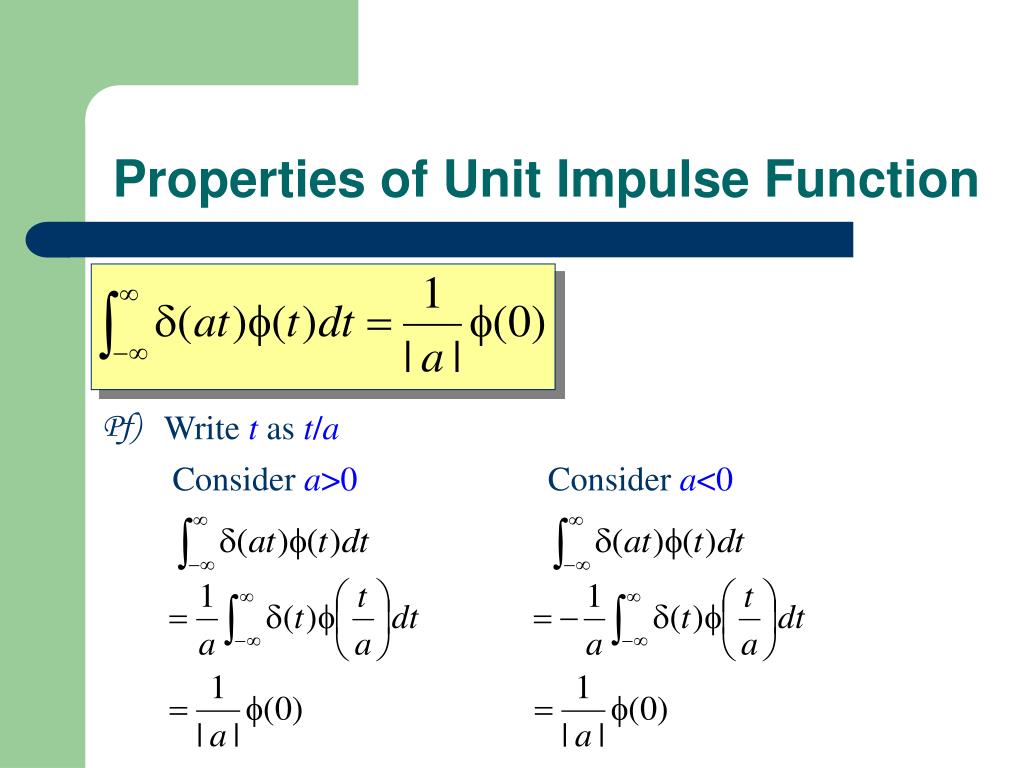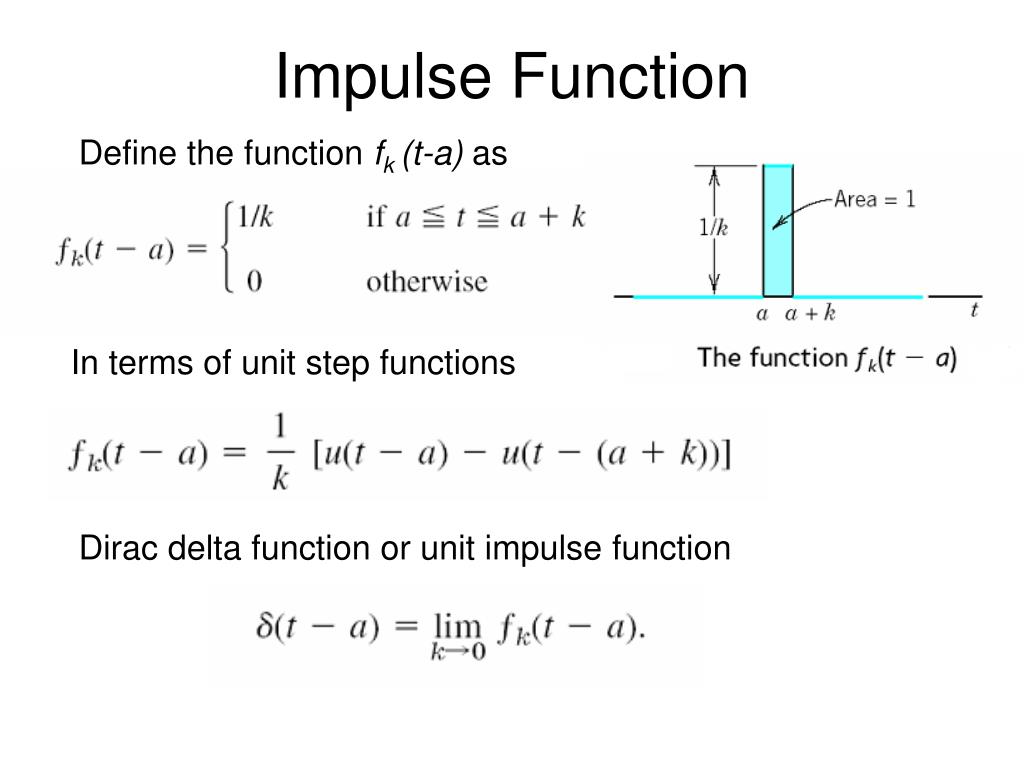
ECE202_Lec7_Part 3 Unit Impulse Function and its Laplace Transform YouTube
The Dirac delta function can be used to represent a unit impulse. Summing over a number of impulses, or point sources, we can describe a general function as shown in Figure 5.9.. The delta function models a unit impulse at \(t=2\). Of course, we anticipate that at this time the spring will begin to oscillate. We will solve this problem using.

ss15_A042 (CT Unit Impulse & Unit Step Functions) YouTube
impulse b F(t) dt a Geometrically, the impulse of F(t) is the area under the curve y = F(t) over interval [a, b]. From the point of view of mechanics, the impulse is the change in momentum of a mass as the force is applied to it over the time interval from a to b. We can see this as follows.

Elementary Signals Unit Impulse Function YouTube
Unit Impulse Function: Use the t-slider to choose the center and the a-slider to choose the half-width of the interval. Let a approach 0 to get an idea of the Dirac delta function.

Unit Impulse Sequence YouTube
The unit impulse function, also known as the Dirac delta function, is a signal that has infinite height and infinitesimal width. However, because of the way it is defined, it integrates to one. While this signal is useful for the understanding of many concepts, a formal understanding of its definition more involved.

PPT Fourier Transforms of Special Functions PowerPoint Presentation ID690933
In mathematical analysis, the Dirac delta function (or δ distribution ), also known as the unit impulse, [1] is a generalized function on the real numbers, whose value is zero everywhere except at zero, and whose integral over the entire real line is equal to one.

The ContinuousTime Unit Impulse Function 1/4 YouTube
Discrete Time Unit Impulse Summary. The discrete time unit impulse function, also known as the unit sample function, is of great importance to the study of signals and systems. The function takes a value of one at time n = 0 n = 0 and a value of zero elsewhere. It has several important properties that will appear again when studying systems.

47. Laplace Transform of Unit Impulse Functions Complete Concept and Formulae Must Watch
Session Overview In this session we study differential equations with step or delta functions as input. For physical systems, this means that we are looking at discontinuous or impulsive inputs to the system. Session Activities Read the course notes: Unit Step and Unit Impulse Response: Introduction (PDF) Initial Conditions (PDF)

Unit Impulse function Properties of unit impulse unit impulse signal unit impulse sequence
6.4.2Delta Function. The Dirac delta function\(^{1}\) is not exactly a function; it is sometimes called a generalized function. We avoid unnecessary details and simply say that it is an object that does not really make sense unless we integrate it.

Impulse Definition, Unit, Formula, Equation Embibe
In discrete time the unit impulse is simply a sequence that is zero ex-cept at n = 0, where it is unity. In continuous time, it is somewhat badly be-haved mathematically, being of infinite height and zero width but having a finite area. The unit step and unit impulse are closely related.

The ContinuousTime Unit Impulse Function 4/4 YouTube
What is its derivative? Define it as: ( t ) = u % ( t ) which has unit area. dt Now, lim u % ( t ) = u ( t ) Δ→ 0 so what if we take lim δ % ( t ) ? Δ→ 0 The pulse height gets higher and higher and its width goes to zero, but its area is still 1! So define δ(t) as unit impulse: And or equivalently, And Also

PPT UNIT STEP FUNCTION PowerPoint Presentation, free download ID6312958
Delta Functions: Unit Impulse. 1. Introduction. In our discussion of the unit step function u(t) we saw that it was an idealized model of a quantity that goes from 0 to 1 very quickly. In the idealization we assumed it jumped directly from 0 to 1 in no time. In this note we will have an idealized model of a large input that acts over a short time.

Unit Impulse Function
(Notice that if the function is even then duality is very simple) f(t) t ! F(!)! 1 0 2! 2!1/2 1/2 1 Cu (Lecture 7) ELE 301: Signals and Systems Fall 2011-12 15 / 22 Generalized Fourier Transforms: Functions A unit impulse (t) is not a signal in the usual sense (it is a generalized function or distribution). However, if we proceed using the.

Laplace Transform of Basic Signals (Unit Impulse Signal) YouTube
The unit impulse function has zero width, infinite height and an integral (area) of one. We plot it as an arrow with the height of the arrow showing the area of the impulse. To show a scaled input on a graph, its area is shown on the vertical axis. In the diagram below the area of the impulse function is "A."

The ContinuousTime Unit Impulse Function 3/4 YouTube
Since MATLAB® is a programming language, an endless variety of different signals is possible. Here are some statements that generate a unit impulse, a unit step, a unit ramp, and a unit parabola. t = (-1:0.01:1)'; impulse = t==0; unitstep = t>=0; ramp = t.*unitstep; quad = t.^2.*unitstep; All of these sequences are column vectors that inherit.

48. Unit Impulse Functions Complete Concept and Problem1 Important Problem YouTube
The unit impulse signal is the most widely used standard signal used in the analysis of signals and systems. Continuous-Time Unit Impulse Signal The continuous-time unit impulse signal is denoted by δ (t) and is defined as − δ(t) = { 1 f or t = 0 0 f orteq0 δ ( t) = { 1 f o r t = 0 0 f o r t e q 0

Lecture 4.25 Math2Laplace Transform of Unit Impulse Function YouTube
To find the unit step response, multiply the transfer function by the area of the impulse, X 0, and solve by looking up the inverse transform in the Laplace Transform table (Exponential) Note: Remember that v (t) is implicitly zero for t<0 (i.e., it is multiplied by a unit step function). Also note that the numerator and denominator of Y (s.